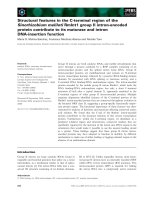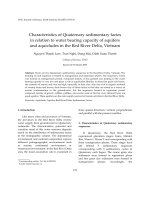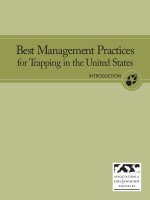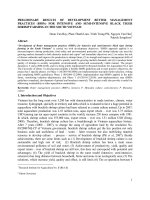BMP5 Best Management Practices to Deter Piracy and Enhance Maritime Security in the Red Sea, Gulf of Aden, Indian Ocean and Arabian Sea.
Bạn đang xem bản rút gọn của tài liệu. Xem và tải ngay bản đầy đủ của tài liệu tại đây (3.98 MB, 77 trang )
BMP5
Best Management Practices to Deter Piracy and Enhance Maritime
Security in the Red Sea, Gulf of Aden, Indian Ocean and Arabian Sea
Produced and supported by:
1
BMP5
Best Management Practices to Deter
Piracy and Enhance Maritime Security in
the Red Sea, Gulf of Aden, Indian Ocean
and Arabian Sea
Version 5 published June 2018
Authors: BIMCO, ICS, IGP&I Clubs, INTERTANKO and OCIMF
Legal Notice
BMP5 has been developed purely as guidance to be used at the user’s own risk. No responsibility is accepted by the
Authors, their Members or by any person, firm, corporation or organisation for the accuracy of any information in BMP5 or
any omission from BMP5 or for any consequence whatsoever resulting directly or indirectly from applying or relying upon
guidance contained in BMP5 even if caused by a failure to exercise reasonable care.
Copyright notice
The Authors of BMP5 have provided BMP5 free of charge. All information, data and text contained in BMP5 whether in
whole or in part may be reproduced or copied without any payment, individual application or written license provided
that:
•
It is used only for non-commercial purposes; and
•
The content is not modified
Exceptions:
The permission granted above permits the photographs to be used within the whole or part of BMP5. The permission
does not extend to using the photographs separately outside of BMP5 as these photographs belong to a third party.
Authorisation to use the photographs separately from BMP5 must first be obtained from the copyright holders, details of
whom may be obtained from the Authors.
Logos and trademarks are excluded from the general permission above other than when they are used as an integral part
of BMP5.
Published by
Witherby Publishing Group Ltd
4 Dunlop Square
Livingston, Edinburgh, EH54 8SB
Scotland, UK
Tel No: +44 (0) 1506 463 227
Fax No: +44 (0) 1506 468 999
Email:
Web: www.witherbys.com
Contents
The fundamental requirements of BMP
iv
Section 1
Introduction
1
Section 2
The threat
4
Section 3
Threat and risk assessment
6
Section 4
Planning
8
Section 5
Ship Protection Measures
11
Section 6
Reporting
21
Section 7
Ships under attack
23
Annex A
Contact details
33
Annex B
Maritime security charts
35
Annex C
Common understanding
36
Annex D
UKMTO reporting forms
38
Annex E
Maritime Security Centre – Horn of Africa reporting forms
40
Annex F
Additional guidance for vessels engaged in fishing
47
Annex G
Additional advice for leisure crat, including yachts
49
Annex H
Definitions and abbreviations
50
Annex I
Supporting organisations
53
Annex J
Voyage reference card
69
iii
The fundamental requirements of
BMP
Understand the threat
• Maritime threats are dynamic.
• Obtaining current threat information is critical for risk assessment and decision making.
Conduct risk assessments
• Companies must conduct risk assessments.
• Identify ship protection measures.
Implement ship protection measures
• Harden the ship.
• Brief and train the crew.
• Enhanced lookout.
• Follow Flag State and military guidance.
Report
• Report to UKMTO and register with MSCHOA.
• Report incidents and suspicious activity.
• Send distress signal when attacked.
Cooperate
• Cooperate with other shipping and military forces.
• Cooperate with law enforcement to preserve evidence.
• Cooperate with welfare providers.
iv
Section 1
Introduction
Seafarers have encountered diferent security threats when operating ships in the Red Sea,
the Gulf of Aden, the Indian Ocean and the Arabian Sea.
The purpose of this publication is to help ships plan their voyage and to detect, avoid, deter,
delay and report attacks. Experience has shown application of the recommendations in this
publication makes a significant diference to the safety of seafarers.
Piracy-specific Best Management Practice (BMP), international navies and capacity building
ashore have helped to suppress piracy. However, Somali piracy has not been eradicated and
remains a threat.
The BMP contained in this publication mitigates the risk from piracy and other maritime
security threats.
Regional instability has introduced other maritime security threats, which include:
• Deliberate targeting of ships by extremist groups.
• Collateral damage arising from regional conflict.
BMP piracy measures are efective, but diferences in attack methods from other threats may
require other forms of mitigation. For example, attacks carried out by extremists may be
more determined, as they may be willing to risk their lives.
The consequences of not adopting efective security measures can be severe. Some pirates
have subjected hostages to violence and other ill treatment and periods of captivity for
some hijacked seafarers have lasted for several years. Other attacks have demonstrated an
intent to damage ships and endanger life.
The United Kingdom Maritime Trade Operations (www.ukmto.org) and Maritime Security
Centre – Horn of Africa (www.mschoa.org) websites should be consulted for advice.
See annex A for contact details.
This BMP complements piracy guidance in the latest International Maritime Organization
(IMO) MSC Circulars (see www.imo.org) and advice on the Maritime Security Transit
Corridor.
Nothing in this BMP detracts from the Master’s overriding authority
and responsibility to protect their crew, ship and cargo.
1
Geographical area
The geography of the region is diverse and ranges from narrow choke points such as the
Bab el Mandeb (BAM) Straits and the Strait of Hormuz to the wide-open ocean of the Somali
basin. Each area presents diferent challenges and threats will vary.
Attacks on ships and seafarers have taken place throughout the region. Threats are dynamic;
information should be sought from the organisations listed in annex A.
Voluntary Reporting Area
The UKMTO Voluntary Reporting Area (VRA) is identified on maritime security charts such as
UKHO Q6099. Ships entering and operating within the VRA are encouraged to register with
the UKMTO. Registration establishes direct contact between the reporting ship and UKMTO.
MSCHOA vessel registration area
The MSCHOA vessel registration area is designed to inform military counter piracy forces of
the transit of merchant ships in the Indian Ocean and the Gulf of Aden. The MSCHOA vessel
registration area is defined on maritime security chart Q6099.
High Risk Area
A High Risk Area (HRA) is an industry defined area within the VRA where it is considered that
a higher risk of attack exists, and additional security requirements may be necessary. The
HRA is outlined on maritime security chart Q6099. It is important the latest information on
current threats is used when planning routes through the HRA. Ships should be prepared to
deviate from their planned route at short notice to avoid threats highlighted by navigation
warnings or by military forces.
Maritime Security Transit Corridor
The Maritime Security Transit Corridor (MSTC) is a military established corridor upon which
naval forces focus their presence and surveillance eforts. The MSTC is shown on maritime
security chart Q6099 and the figure below and consists of:
• The Internationally Recommended Transit Corridor (IRTC).
- The IRTC is not a Trafic Separation Scheme (TSS) but an established transit corridor
in the Gulf of Aden where naval forces focus their counter piracy patrols. Within the
IRTC, group transits and national convoys may be ofered.
• The BAM TSS and the TSS West of the Hanish Islands.
• A two-way route directly connecting the IRTC and the BAM TSS.
It is recommended that ships use the MSTC to benefit from the military presence and
surveillance.
2
Joint War Committee listed area
The insurance community may list an area of perceived enhanced risk in the region. Ships
entering the area would need to notify their insurers and additional insurance premiums
may apply. The Joint War Committee (JWC) comprises underwriting representatives from
both Lloyd’s and the International Underwriting Association representing the interests of
those who write marine hull war business in the London market. The geographic limits of the
JWC listed area can be found on their website: www.lmalloyds.com/lma/jointwar.
3
Section 2
The threat
As well as piracy, regional instability has introduced new security threats including the use
of:
• Anti-ship missiles.
• Sea mines.
• Water-Borne Improvised Explosive Devices (WBIED).
Piracy
Pirates operate in Pirate Action Groups (PAG) who operate several diferent boat
configurations, typically using small high speed (up to 25 knots) open boats or skifs.
PAG boat configurations include:
• Skifs only.
• Open whalers carrying significant quantities of fuel and oten towing one or more attack
skifs.
• Motherships, which include merchant ships and fishing vessels but, more commonly,
dhows.
Where motherships are used the crew are oten held onboard as hostages. Motherships are
used to carry pirates, stores, fuel and attack skifs to enable pirates to operate over a much
larger area and are significantly less afected by the weather. Attack skifs are oten towed
behind motherships. Where the size of the mothership allows, skifs may be carried onboard
and camouflaged.
Pirates may use small arms fire and Rocket Propelled Grenades (RPGs) to intimidate Masters
of ships to reduce speed or stop to allow them to board. The bridge and accommodation
tend to be the main targets for these weapons.
Pirates use long lightweight ladders, knotted climbing ropes or long hooked poles to climb
up the side of the ship. Once onboard they will make their way to the bridge to try to take
control of the ship. When on the bridge they will demand the ship slows/stops to enable
other pirates to board.
Attacks can take place at any time – day or night – however experience shows attacks at
dawn and dusk are more likely.
4
The intent of Somali pirates is to hijack the ship and hold the crew for ransom. The usual
practice is to keep the crew onboard as negotiations progress, keeping both the crew and
the ship together. Seafarers have occasionally been separated by nationality and taken
ashore. It is in the interests of the pirates to keep their captives alive, although cases of
intimidation and torture have occurred.
Anti-ship missiles
Anti-ship missiles are long range, accurate and powerful weapons and have been used
against military ships in the region. Their use against merchant ships associated with
regional conflict cannot be discounted. Other ships may be hit if the missile controller
targets the wrong ship or the missile homes in on an unintended target.
Sea mines
Sea mines have been used to deter and deny access to key ports in Yemen. These mines
are usually tethered or anchored but may break free from moorings and drit into shipping
lanes. Transiting merchant ships are not a target and it is recommended ships use the MSTC
when passing through the area.
Water-Borne Improvised Explosive Devices
WBIED attacks have been used against warships and merchant ships in the southern Red
Sea/BAM/western area of the Gulf of Aden.
Incidents have highlighted attacks by diferent groups operating in the region:
• WBIED used in the regional conflict have been aimed at harming those associated with
the conflict. These boats have been unmanned and operated remotely.
• WBIED used by extremists have been aimed at merchant ships. These boats have been
manned.
An attack involving a WBIED is likely to involve one or more speed boats operated by a
number of individuals approaching and firing both small arms and RPGs. Masters should
recognise the intent of these attacks is to cause damage and not necessarily to board the
ship. Mitigation measures to prevent the speed boat making contact with the ship’s hull are
limited.
5
Section 3
Threat and risk assessment
Threat assessment
The threat assessment must include all regional security threats.
As part of every ship risk assessment prior to transit through the HRA the latest military
threat advice must be obtained from UKMTO www.ukmto.org and threat assessments
from MSCHOA www.mschoa.org (see annex A).
A threat is formed of capability, intent and opportunity.
Capability means attackers have the physical means to conduct an attack. Intent is
demonstrated by continued attacks. Opportunity is what is mitigated by the company, ship
and crew through application of the measures described in this guidance. In addition to the
information provided in this guidance, supplementary information about the characteristics
of the threat, specific or new tactics, and regional background factors may be sought from
regional reporting centres and organisations as listed in annex A.
If one side of the triangle is removed, then risk is minimised. The company/Master cannot
influence either capability or intent, therefore BMP measures focus on minimising the
opportunity.
6
Risk assessment
Risk assessment is an integral part of voyage planning within a safety management system.
The risk assessment should identify measures for prevention, mitigation and recovery,
which will mean combining statutory regulations with supplementary measures. Companies
should also take account of these measures for ships transiting the VRA even if they do not
enter the HRA.
Further guidance on risk assessments can be found in the Global Counter Piracy Guidance
at www.maritimeglobalsecurity.org.
The risk assessment must consider but may not be limited to:
• Requirements of the Flag State, company, charterers and insurers.
• The threat assessment and geographical areas of increased risk.
• Background factors shaping the situation, e.g. trafic patterns and local patterns of life,
including fishing vessel activity.
• Cooperation with military. An understanding of presence should be obtained from
UKMTO.
• The embarkation of Privately Contracted Armed Security Personnel (PCASP).
• The ship’s characteristics, vulnerabilities and inherent capabilities, including citadel and/
or safe muster points to withstand the threat (freeboard, speed, general arrangement,
etc.).
• The ship’s and company’s procedures (drills, watch rosters, chain of command, decision
making processes, etc.).
All voyages in this region require thorough advanced planning using all available
information. The maritime threats are dynamic, and it is therefore essential that a detailed
threat and risk assessment is completed for each voyage and activity within the region.
7
Section 4
Planning
Company planning
Together with the following, the output of the risk assessment will help develop the ship’s
voyage plan:
• Regular review of the threat and risk assessments. Plans should be updated as necessary.
• Review of the Ship Security Assessment (SSA), Ship Security Plan (SSP) and Vessel
Hardening Plan (VHP).
• Guidance to the Master about the recommended route, updated plans and requirements
for group transits and national convoys.
• Company mandated Ship Protection Measures (SPM).
• Due diligence of Private Maritime Security Companies (PMSCs) for the possible use of
PCASP.
• Companies should consider the placement of hidden position transmitting devices as one
of the first actions of hijackers is to disable all visible communication and tracking devices
and aerials.
• Review of company manning requirements. Consider disembarking of non-essential crew.
• Crew training plans.
Information security
To avoid critical voyage information falling into the wrong hands the following is advised:
• Communications with external parties should be kept to a minimum, with close attention
paid to organising rendezvous points and waiting positions.
• Email correspondence to agents, charterers and chandlers should be controlled and
information within the email kept concise, containing the minimum that is contractually
required.
8
Ship Master’s Planning
Security is a key part of any voyage plan.
Prior to entering the Voluntary Reporting Area
• Obtain the latest threat information.
• Check the latest NAVAREA warnings and alerts.
• Implement VRA/MSCHOA vessel registration and reporting requirements as highlighted in
section 6 and annexes D and E.
• If used, confirm PCASP embarkation plan.
• Confirm propulsion can operate at full speed.
Prior to entering the High Risk Area
• Implement security measures in accordance with the SSP.
Brief crew and conduct drills
The crew should be fully briefed on the preparations and drills should be conducted with
the SPM in place. The plan should be reviewed and all crew briefed on their duties, including
familiarity with the alarm that signals an attack, an all-clear situation and the appropriate
response to each. The drills should test:
• The SPM, including testing the security of all access points.
• Lock down conditions, including crew safety considerations.
• The bridge team’s security knowledge.
• The crew’s understanding of any diferent actions required in the event of a pirate attack
compared to other types of attack.
Other considerations
• Prepare and test an emergency communication plan. Masters are advised to prepare an
emergency communication plan, to include all essential emergency contact numbers
(see annex A) and prepared messages, which should be at hand or permanently displayed
near all external communications stations including safe muster point and/or the citadel.
Communication devices and the Ship Security Alert System (SSAS) should be tested.
• Define the ship’s Automatic Identification System (AIS) policy. It is recommended that AIS
should remain switched on throughout passages through passages through the VRA and
HRA, to ensure militaries can track the ship, but restrict data to ship’s identity, position,
course, speed, navigational status and safety related information.
• Reschedule planned maintenance on voyage critical equipment for transit of an HRA.
9
On entering the High Risk Area
• Submit ship reports as highlighted in section 6 and annexes D and E.
• Monitor latest threat information.
• Ensure all access points are limited and controlled.
• Avoid driting, waiting, anchoring and slow steaming, particularly in the MSTC.
• Minimise use of VHF and use email or a secure satellite telephone instead. Where possible
only answer known or legitimate callers on the VHF, bearing in mind that imposters are
possible.
10
Section 5
Ship Protection Measures
This section highlights proven SPM that provide layered protection. The BMP is based on
regional experience of attacks and will continue to evolve as methods change.
The implementation of SPM will be identified during the voyage planning process.
Companies may wish to consider making further alterations to the ship beyond the scope
of this BMP, and/or providing additional equipment and/or personnel as a means of further
reducing the risk of attack.
Primary layer of defence
Good look out/vigilance.
Razor wire.
Manoeuvring.
Speed/freeboard.
PCASP.
Secondary layer of defence
Door hardening.
Gate/grate.
Motion sensor/CCTV.
Last layer of defence
Internal door hardening.
Citadel/safe muster point.
Communication.
Watch keeping and enhanced vigilance
The Master should implement the following actions to assist in raising vigilance on board.
• Provide additional, fully-briefed lookouts.
• Maintain an all-round lookout from an elevated position.
• Consider shorter rotation of the watch period to maximise alertness of the lookouts.
• Maintain sufficient binoculars for the enhanced bridge team, preferably anti-glare.
• Consider the use of thermal imagery optics and night vision aids as they provide a reliable
all-weather, day and night surveillance capability.
• Maintain a careful radar watch and monitor all navigational warnings and
communications, particularly VHF and GMDSS alerts.
• Consider placing well-constructed dummies at strategic locations around the ship to give
the impression of greater numbers of crew on watch.
11
• Consider using CCTV and fixed search lights for better monitoring. Fixed search lights can
deter approaches from the stern.
• Mount anti-piracy mirrors on the bridge wings to make looking at easier.
An efective lookout is the most efective method of ship
protection. It can help identify a suspicious approach or attack
early on, which allows defences to be deployed.
Manoeuvring
The Master and oficers should practice manoeuvring the ship to ensure familiarity with
the ship’s handling characteristics. The Master should also practice avoidance manoeuvres
while maintaining the best possible speed. Experience has shown that such action can
defeat even a lengthy and determined attack as creation of hydrostatic pressure can have a
better defensive impact than speed.
Avoidance manoeuvres should only be practiced when it is
safe to do so.
Alarms
The ship’s alarms inform the ship’s crew that an attack is underway and warn the attacker
that the ship is aware and is reacting. In addition, continuous sounding of the ship’s whistle
may distract the attackers.
It is important that:
• The alarms are distinctive to avoid confusion.
• Crew members are familiar with each alarm, especially
those warning of an attack and indicating ‘all clear’.
• All alarms are backed up by an announcement over the
accommodation and deck PA system, where fitted.
• Drills are carried out to ensure that the alarm is heard
throughout the ship. The drill will confirm the time
necessary for all crew to move to a position of safety.
12
Physical barriers
Physical barriers are intended to make it as dificult as possible for attackers to gain access
to ships by increasing the dificulty of the climb for those trying to illegally board. When
planning the placement of barriers special consideration should be given to ships with
sunken poop decks.
Razor wire
Also known as barbed tape. It creates an efective barrier if properly rigged and secured. The
quality of razor wire varies considerably and lower quality razor wire is less efective. The
following is recommended:
• Use a high tensile concertina razor wire with coil
diameters of 730mm or 980mm. This is dificult to
cut with hand tools.
• Use a double roll. If this is not possible, place
a single high-quality roll outboard of the ship’s
structure.
• Secure razor wire to the ship properly, to prevent
attackers pulling the wire of. For example, attach
at least every third wire ring to ship’s railings and
rig a steel cable through its core.
• Use personal protective equipment and wire
hooks to move and install razor wire.
• Obtain razor wire in short sections, e.g. 10m, so
that it is easier and safer to move.
• Keep razor wire clear of mooring fairleads when
at terminals so that it does not interfere with
mooring operations.
13
Other physical barriers
Other barriers have proven efective – from hanging
swinging obstacles over the gunnels to specifically
designed overhanging protection that prevents illegal
boarding by climbing over the ship’s rails.
Water spray and foam monitors
• The use of water spray and/or foam monitors is
efective in deterring or delaying any attempt to
illegally board a ship. The use of water can make
it dificult for an unauthorised boat to remain
alongside and makes it significantly more dificult
to climb aboard.
• It is recommended hoses and foam monitors
(delivering water) are fixed in position to cover likely
access routes and are remotely operated. Manual
activation is not recommended as this may place the operator in an exposed position.
• Improved water coverage may be achieved by using fire hoses in jet mode and using bafle
plates fixed a short distance in front of the nozzle.
• Water cannons deliver water in a vertical sweeping arc and protect a greater part of the
hull.
• Water spray rails with spray nozzles produce a water curtain covering larger areas.
• Foam can be used, but it must be in addition to a ship’s standard fire fighting equipment
stock. Foam is disorientating and very slippery.
• The use of all available fire and general service pumps may be required to ensure all
defences operate eficiently.
• Additional power may be required when using pumps; the supporting systems should be
ready for immediate use.
• Practice, observation and drills are required to ensure the equipment provides efective
coverage of vulnerable areas.
14
Enhanced bridge protection
The bridge is usually the focal point of an attack. In some situations, attackers direct their
weapon fire at the bridge to intimidate the ship’s crew to slow or stop the ship. If pirates
board the ship, they usually make for the bridge to enable them to take control.
The following enhancements may be
considered:
• Bridge windows are laminated but further
protection against flying glass can be
provided by the application of blast
resistant film.
• Fabricated metal (steel/aluminium) plates
for the side and rear bridge windows and
the bridge wing door windows, which can
be quickly secured in place in the event of
an attack can greatly reduce the risk of injury from fragmentation.
• Chain link fencing can be used to reduce the efects of an RPG.
• Sandbags can provide additional protection on the bridge wings. They should be regularly
checked to ensure that they have not degraded.
Control of access to accommodation and machinery spaces
It is important to control access routes to the accommodation and machinery spaces to
deter or delay entry. Efort must be directed at denying access to these spaces.
• Escape routes must remain accessible to seafarers in the
event of an emergency.
• Where the door or hatch is located on an escape route
from a manned compartment, it is essential it can be
opened from the inside. Where the door or hatch is locked
it is essential a means of opening the door from the inside
is available.
15
• Doors and hatches providing access to the bridge, accommodation
and machinery spaces should be properly secured to prevent them
being opened from the outside.
• Once doors and hatches are secured, a designated and limited
number are used for security patrols and routine access. The use
of these doors or hatches should be controlled by the Oficer of the
Watch.
• Block external stairs or remove ladders on the accommodation block to prevent use and
to restrict external access to the bridge.
• Doors and hatches that must be closed for watertight integrity should be fully dogged
down in addition to any locks. Where possible, additional securing mechanisms, such as
wire strops, may be used.
• Removable barriers should be used around pilot boarding points so that a ship does not
need to de-rig large areas prior to arrival at ports.
• Pirates have been known to gain access through portholes and windows. The fitting of
steel bars to portholes and windows will prevent this.
• Procedures for controlling access to accommodation, machinery spaces and store rooms
should be briefed to the crew.
• The attackers must be denied access to ship propulsion.
Safe muster points and/or citadels
The company risk assessment and planning process should identify the location of a safe
muster point and/or a citadel within a ship.
Safe muster points
A safe muster point is a designated area chosen to provide maximum physical protection to
the crew and will be identified during the planning process.
If the threat assessment identifies risks that may result in a breach of hull on or below the
waterline then a safe muster point above the waterline must be identified. In many ships, the
central stairway may provide a safe location as it is protected by the accommodation block
and is above the waterline.
16
To minimise the efect of an explosion, consideration should be given to the likely path of
the blast. The safe muster point should be selected with this in mind.
Citadels
A citadel is a designated area where, in the event of imminent boarding, all crew may seek
protection. A citadel is designed and constructed to resist forced entry. The use of a citadel
cannot guarantee a military or law enforcement response.
Well-constructed citadels with reliable communications (ideally satellite phone and VHF)
must be supplied with food, water and sanitation. Control of propulsion and steering can
ofer efective protection during an attack. If citadels are used, they must complement, not
replace, all other SPM.
The use of the citadel must be drilled and the SSP should define the conditions and
supporting logistics for its use.
It is important to note that military forces are likely to apply the following criteria before
boarding a ship:
• All the crew must be accounted for and confirmed in the citadel.
• Two-way communication with the citadel.
The Master should decide when to use the citadel.
17
Other measures
Closed circuit television
Once an attack is underway it may be dificult to
assess whether the attackers have gained access
to the ship. The use of CCTV coverage allows a
degree of monitoring of the progress of the attack
from a less exposed position. Some companies
can monitor and record the CCTV from ashore,
which will be of value when provided to the military. The following should be considered:
• CCTV cameras for coverage of vulnerable areas, particularly the poop deck and bridge.
• CCTV monitors located on the bridge and at the safe muster point/citadel.
• CCTV footage may provide useful evidence ater an attack and should be retained.
Lighting
Lighting is important and the following is recommended:
• Weather deck lighting around the accommodation block and rear facing lighting on the
poop deck to demonstrate awareness.
• If fitted, search lights ready for immediate use.
• Once attackers have been identified or an attack commences, over side lighting, if fitted,
should be switched on. This will dazzle the attackers and help the ship’s crew to see them.
• At night, only navigation lights should be exhibited.
• Navigation lights should not be switched of at night as this a contravention of
international regulations and the risk of collision is higher than that of being attacked.
• At anchor, deck lights should be let on as well-lit ships are less vulnerable to attack.
• The ability to turn of all internal accommodation lights to deter pirates from entering or
disorientate those who may already have entered.
Deny the use of ship’s tools and equipment
It is important to secure ship’s tools or equipment that may be used to gain entry to the ship.
Tools and equipment that may be of use to attackers should be stored in a secure location.
Protection of equipment stored on the upper deck
• Consideration should be given to providing ballistic protection to protect gas cylinders or
containers of flammable liquids.
• Excess gas cylinders should be stored in a secure location or, if possible, landed prior to
transit.
18
Private Maritime Security Companies
This section provides guidance on the employment of PMSCs. PMSCs may ofer armed or
unarmed services. Further guidance on the use of armed services (PCASP) is given below.
BMP does not recommend or endorse the general use of PMSCs onboard merchant ships;
this is a decision taken by individual ship operators where permitted by the ship’s Flag State
and any littoral states. However, the use of experienced and competent unarmed PMSCs
can be a valuable protective measure, particularly where there may be the requirement
to interface and coordinate with local law enforcement agencies, naval forces and coast
guards.
Any decision to engage the services of a PMSC should consider:
• The current threat and risk environment.
• The output of the company risk assessment.
• Voyage plan requirements.
• Ship speed.
• Freeboard.
• Type of operations, e.g. seismic survey or cable laying.
• Levels of protection provided by navies, coastguards and maritime police.
Some Flag States do not allow the deployment of PMSC.
It is recommended that shipping companies only employ PMSCs who are accredited to
the current ISO 28007-1:2015 Guidelines for Private Maritime Security Companies (PMSC)
providing privately contracted armed security personnel (PCASP) on board ships.
A PMSC contract must:
• Be between the technical manager and the PMSC.
• Not prejudice the ship’s insurance cover arrangements.
• Ensure the PMSC has insurance policies that are current and compliant with the
requirements of the contract.
• Clearly identify the procedure for the use of force.
• Confirm the Master’s overriding authority.
Privately Contracted Armed Security Personnel
Any decision to engage the services of PCASP should consider the guidance above for PMSC as
well as the following.
BMP does not recommend or endorse the general use of PCASP onboard merchant ships; this
is a decision taken by individual ship operators where permitted by the ship’s Flag State and
any littoral states.
19









